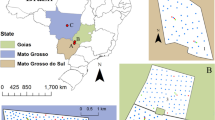Abstract
Although several researchers have pointed out some advantages and disadvantages of various soil sampling designs in the presence of spatial autocorrelation, a more detailed study is presented herein which examines the geometrical relationship of three sampling designs, namely the square, the equilateral triangle, and the regular hexagon. Both advantages and disadvantages exist in the use of these designs with respect to estimation of the semivariogram and their effect on the mean square error or variance of error. This research could be used to design optimal sampling strategies; it is based on the theory of regionalized variables, in which the intrinsic hypothesis is satisfied. Among alternative designs, an equilateral triangle design gives the most reliable estimate of the semivariogram. It also gives the minimum maximum mean square error of point estimation of the concentration over the other two designs for the same number of measurements when the nugget effect is small relative to the variance. If the nugget effect is large (.90 σ2 or more), and the linear sampling density is >0.85r where r is the range, the hexagonal design is best. This study computes and compares the maximum mean square error for each of these designs.
Similar content being viewed by others
References
Borgman, L. E., 1973, Spectrum Analysis of Random Data: University of Wyoming Press, Laramie, Wyoming, p. 1–392.
Box, G. and Jenkins, G. M., 1976, Time Series Analysis: Holden Day, San Francisco, California, p. 1–575.
David, M., 1977, Geostatistical Ore Reserve Estimation: Elsevier, Amsterdam, p. 1–364.
Davis, John C., 1973, Statistics and Data Analysis in Geology: John Wiley & Sons, New York, p. 298–407.
Journel, A. G. and Huijbregts, G. T., 1978, Mining Geostatistics: Academic Press, London, p. 1–600.
McBratney, A. B., Webster, R., and Burgess, T. M., 1981, The Design of Optimal Sampling Schemes for Local Estimation and Mapping of Regionalized Variables-I: Comput. Geosci., v. 7, n. 4, p. 331–334.
Olea, R. A., 1975, Optimum Mapping Techniques Using Regionalized Variable Theory: Kansas Geological Survey, University of Kansas, Lawrence, Kansas, p. 1–137.
Olea, R. A., 1984, Systematic Sampling of Spatial Functions: Kansas Geological Survey, University of Kansas, Lawrence, Kansas, Series on Spatial Analysis No. 7, p. 1–57.
Author information
Authors and Affiliations
Rights and permissions
About this article
Cite this article
Yfantis, E.A., Flatman, G.T. & Behar, J.V. Efficiency of kriging estimation for square, triangular, and hexagonal grids. Math Geol 19, 183–205 (1987). https://doi.org/10.1007/BF00897746
Received:
Accepted:
Issue Date:
DOI: https://doi.org/10.1007/BF00897746




